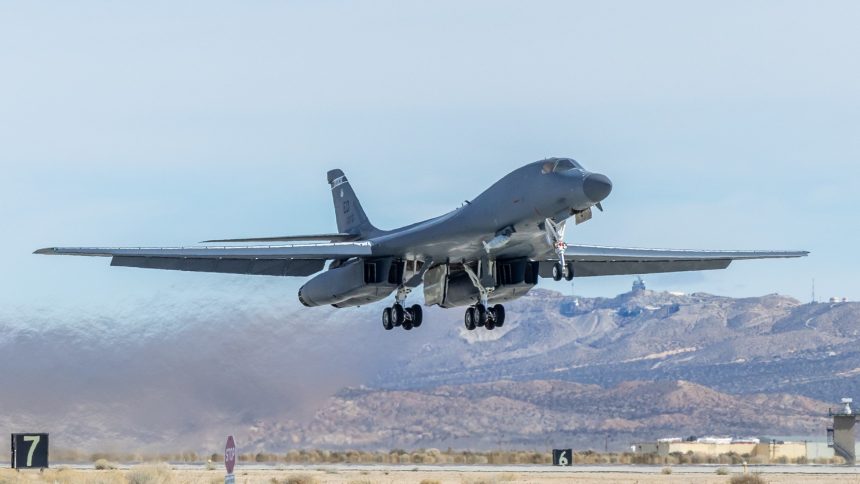The B-1B Lancer bomber will be able to use up to six Load Adaptable Modular pylons under the fuselage to carry heavy standoff munitions and hypersonic weapons.
The U.S. Air Force has awarded Boeing a contract to procure the new Load Adaptable Modular (LAM) pylons for the B-1B Lancer bomber. The new pylons will allow the BONE (from “B-One”, as the aircraft is unofficially nicknamed) to carry externally a variety of weapons with fewer constraints compared to older systems.
The procurement
The procurement of the new system is also mentioned in the Fiscal Year 2026 budget proposal’s Justification Book under the B-1B external heavy-stores pylon program. The pylons will provide increased carriage capacity of standoff munitions on the bomber, with a budget of $10 million in FY2025 and $68.7 in FY2026.
“Maximum carriage of existing standoff munitions on the B-1B provides a near-term solution to fill the operational need to increase volume of fires from standoff ranges to close existing combatant command gaps,” says the document. “This increased volume serves to mitigate transition risk of the Air Force bomber fleet prior to the emergence of the B-21 as a combat capable bomber.”
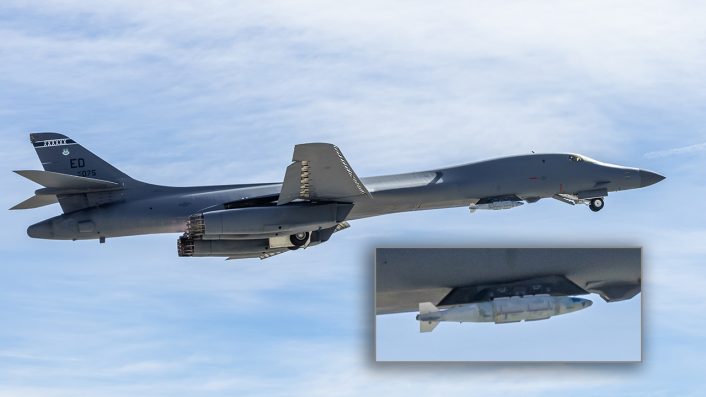
The Justification Book specifically mentions that the system being acquired is the LAM pylon. Additionally, the document notes that “Design development of Load Adjustable Module (LAM) was completed with the previous FY 2022 and FY 2023 Congressional add funding to allow the B-1 to be a test bed for Hypersonic weapons.”
It appears this is not the only mention of the hypersonic weapons, as The War Zone reported that budget document also noted “the Hypersonic Integration Program successfully demonstrated the B-1’s ability to execute a captive carry of a 5,000-pound class store and the release of a proven weapon shape from a Load Adaptable Modular (LAM) pylon.”
Boeing explained in a press release that the pylons were “designed and prototyped through independent research and development funds ahead of a formal Air Force request.” The pylons were then shown during testing at Edwards Air Force Base, California, in 2024.
“Our team identified an opportunity to help the U.S. Air Force achieve their mission even more effectively,” said Troy Dawson, Bombers Development vice president. “They found a creative and innovative way to get new capability to the warfighter to stay ahead of current and emerging threats. They helped ensure the B-1 will be a key part of the U.S. bomber force for decades to come.”
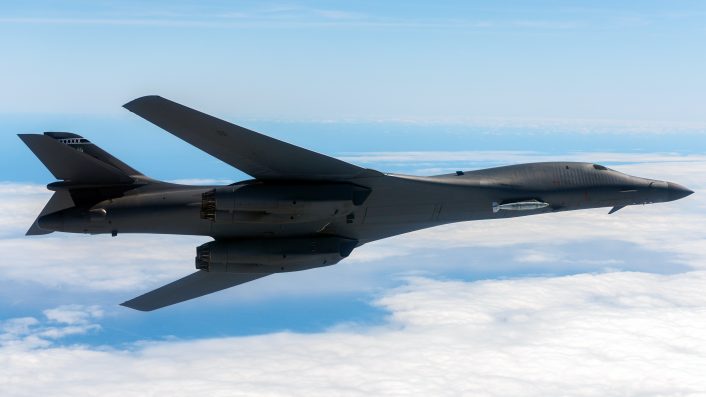
LAM pylons
The LAM pylon, designed by Boeing, is intended to carry a variety of standard and emerging weapons with seamless transition, allowing for maximum agility while also strengthening weapon test infrastructure, according the U.S. Air Force. The new weapons pylon was tested a on a B-1B Lancer test aircraft with the 419th Flight Test Squadron at Edwards Air Force Base in early 2024.
“The B-1 LAM pylon is going to be used to allow us to carry a variety of different weapons and different weapons configurations on the external pylons of the B-1,” said Lt. Col. Scott Pontzer, 419th Flight Test Squadron Commander last year. “That will enable weapon delivery and testing in a variety of different configurations and to include new different weapon release profiles.”
As mentioned earlier, the new Load Adaptable Modular (LAM) pylon was developed by Boeing with its own funds, before proposing it to the Air Force. The company found that the service could need a pylon to test newer and heavier weapons, but “at the time didn’t have the funding for it or the requirement for it, and so we stepped in,” said Jennifer Wong, Boeing’s director of bomber programs.
“mock-up” pylon and missles of Boeing’s load adaptable modular(LAM)https://t.co/8m4rw9Uu7s pic.twitter.com/n21y94CO8d
— 笑脸男人 (@lfx160219) May 26, 2023
“The LAM Pylon will start a new chapter in the B-1’s story,” said Dan Ruder, Bombers Advanced Programs Manager in Boeing’s latest press release. “It will expand its role in the Air Force’s future operational capabilities.”
When the existence of the pod was unveiled in 2023, Boeing already built four of the pylons. The service then granted the company some congressional add-on funds for hypersonic systems, possibly the Hypersonic Integration Program mentioned in the budget documents, and put it into testing at Edwards AFB.
“Testing proved that our rapid development met the Air Force requirements,” Ruder said. “We know that this type of innovation can be a vital asset for the U.S. Air Force and help the B-1 platform continue to adapt to evolving operational needs.”
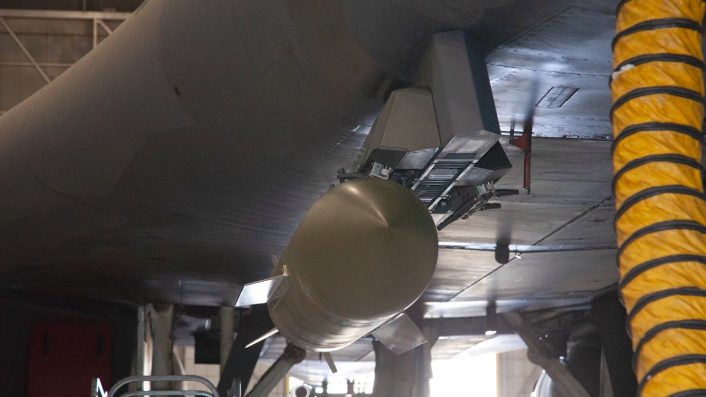
Boeing’s idea was to shift hypersonic weapons’ testing from the B-52 to the B-1 using the new pylon, while increasing by 50% the BONE’s payload. The company says the “Air Force intends to use the B-1 and pylons to test hypersonic weapons in the near term.”
Boeing explained the B-1 can accommodate six pylons, each capable of loading two 2,000-pound-class weapons or a 5,000-pound-plus-class future weapon. The pylons will be installed on the external hardpoints that were initially present on the B-1B and later removed.
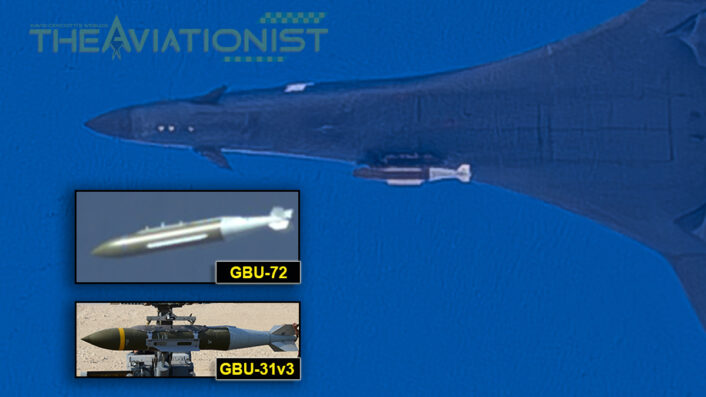
A 5,000-pound was already tested with LAM, as a video released by the Air Force appears to show a GBU-72/B Advanced 5K Penetrator, first fully assembled in still shot and later without the strakes/fins installed during a ground drop test. As we reported in June 2024 here at The Aviationist, a B-1B was spotted carrying for the first time the new 5,000 pound “Bunker Buster” flying over the Mojave Desert. While the images do not allow for a precise identification, it is possible that the bomber was employing the new LAM pylon to carry the GBU-72.

